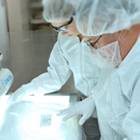INTEGRATED+DNA+TECHNOLOGIE
Artikel-Nr:
(BOSSBS-3097R-CY5.5)
Lieferant:
Bioss
Hersteller-Artikelnummer::
BS-3097R-CY5.5
Lokale Artikelnummer::
BOSSBS-3097R-CY5.5
Beschreibung:
Protein kinase involved in the regulation of transcription. Member of the cyclin-dependent kinase pair (CDK9/cyclin-T) complex, also called positive transcription elongation factor b (P-TEFb), which facilitates the transition from abortive to productive elongation by phosphorylating the CTD (C-terminal domain) of the large subunit of RNA polymerase II (RNAP II) POLR2A, SUPT5H and RDBP. This complex is inactive when in the 7SK snRNP complex form. Phosphorylates EP300, MYOD1, RPB1/POLR2A and AR, and the negative elongation factors DSIF and NELF. Regulates cytokine inducible transcription networks by facilitating promoter recognition of target transcription factors (e.g. TNF-inducible RELA/p65 activation and IL-6-inducible STAT3 signaling). Promotes RNA synthesis in genetic programs for cell growth, differentiation and viral pathogenesis. P-TEFb is also involved in cotranscriptional histone modification, mRNA processing and mRNA export. Modulates a complex network of chromatin modifications including histone H2B monoubiquitination (H2Bub1), H3 lysine 4 trimethylation (H3K4me3) and H3K36me3; integrates phosphorylation during transcription with chromatin modifications to control co-transcriptional histone mRNA processing. The CDK9/cyclin-K complex has also a kinase activity towards CTD of RNAP II and can substitute for CDK9/cyclin-T P-TEFb in vitro. Replication stress response protein; the CDK9/cyclin-K complex is required for genome integrity maintenance, by promoting cell cycle recovery from replication arrest and limiting single-stranded DNA amount in response to replication stress, thus reducing the breakdown of stalled replication forks and avoiding DNA damage. In addition, probable function in DNA repair of isoform 2 via interaction with KU70/XRCC6. Promotes cardiac myocyte enlargement.
VE:
1 * 100 µl
Artikel-Nr:
(BOSSBS-13119R-A488)
Lieferant:
Bioss
Hersteller-Artikelnummer::
BS-13119R-A488
Lokale Artikelnummer::
BOSSBS-13119R-A488
Beschreibung:
Comparative evaluation of the expression patterns of the human and mouse genes, combined with previous biochemical and yeast genetic studies, indicate that the Exo1 (Exonuclease I) proteins are important contributors to chromosome processing during mammalian DNA repair and recombination. In mice, the Exo1 gene maps to distal chromosome 1, consistent with the recent mapping of the orthologous human HEX1/EXO1 gene to chromosome 1q43. Exo1 is expressed prominently in testis, an area of active homologous recombination, and spleen, a prominent lymphoid tissue. In both mammalian and yeast systems, Exo1 is a 5'-3' double stranded DNA exonuclease that has previously been implicated in DNA mismatch repair (MMR). The MMR system ensures genome integrity by removing mispaired and unpaired bases that originate during replication. In humans, Exo1 interacts with MSH2 and MLH1 and has been proposed to be a redundant exonuclease in MMR. In both mammalian and yeast systems, Exo1 plays a structural role in MMR and stabilizes multiprotein complexes containing a number of MMR proteins.
VE:
1 * 100 µl
Artikel-Nr:
(BOSSBS-7674R-A680)
Lieferant:
Bioss
Hersteller-Artikelnummer::
BS-7674R-A680
Lokale Artikelnummer::
BOSSBS-7674R-A680
Beschreibung:
This gene encodes a highly glycosylated transmembrane protein with a high content of threonine and serine residues in its extracellular domain, similar to a broadly defined category of proteins termed mucins. Exposure of some cell types to anti PORIMIN (pro oncosis receptor inducing membrane injury) antibody, crosslinks this protein on the cell surface and induces a type of cell death termed oncosis. Oncosis is distinct from apoptosis and is characterised by a loss of cell membrane integrity without DNA fragmentation. This gene product is proposed to function as a cell surface receptor that mediates cell death.
VE:
1 * 100 µl
Artikel-Nr:
(BOSSBS-7674R-FITC)
Lieferant:
Bioss
Hersteller-Artikelnummer::
BS-7674R-FITC
Lokale Artikelnummer::
BOSSBS-7674R-FITC
Beschreibung:
This gene encodes a highly glycosylated transmembrane protein with a high content of threonine and serine residues in its extracellular domain, similar to a broadly defined category of proteins termed mucins. Exposure of some cell types to anti PORIMIN (pro oncosis receptor inducing membrane injury) antibody, crosslinks this protein on the cell surface and induces a type of cell death termed oncosis. Oncosis is distinct from apoptosis and is characterized by a loss of cell membrane integrity without DNA fragmentation. This gene product is proposed to function as a cell surface receptor that mediates cell death.
VE:
1 * 100 µl
Artikel-Nr:
(BOSSBS-13010R-CY5)
Lieferant:
Bioss
Hersteller-Artikelnummer::
BS-13010R-CY5
Lokale Artikelnummer::
BOSSBS-13010R-CY5
Beschreibung:
DNA repair proteins are necessary for the maintenance of chromosome integrity and are involved in the elimination of premutagenic lesions from DNA. The DNA repair proteins Rad51 and Rad52 are key components of the double-strand-break repair (DSBR) pathway. Rad51 is essential for mitotic and meiotic recombination, and its mutation in yeast and mammalian cells results in chromosome loss. Overexpression of Rad52 confers resistance to ionizing radiation and induces homologous intrachromosomal recombination. Rad52 is thought to be involved in an early stage of Rad51-mediated recombination. Additional proteins involved in the pathway include Nibrin and Dmc1. Nibrin, which complexes with Mre11 and Rad50, is absent in Nijemegen breakage syndrome (NBS) patients. Dmc1 is specifically involved in meiotic recombination. An alternative spliced form of Dmc1, designated Dmc1-D, is deleted for a region between the two motifs involved in nucleotide binding. The alternatively spliced Dmc1-D transcript is detected in both male and female germ cells, indicating that the encoded protein may have a role in mammalian genetic recombination in meiosis.
VE:
1 * 100 µl
Artikel-Nr:
(BOSSBS-13119R-HRP)
Lieferant:
Bioss
Hersteller-Artikelnummer::
BS-13119R-HRP
Lokale Artikelnummer::
BOSSBS-13119R-HRP
Beschreibung:
Comparative evaluation of the expression patterns of the human and mouse genes, combined with previous biochemical and yeast genetic studies, indicate that the Exo1 (Exonuclease I) proteins are important contributors to chromosome processing during mammalian DNA repair and recombination. In mice, the Exo1 gene maps to distal chromosome 1, consistent with the recent mapping of the orthologous human HEX1/EXO1 gene to chromosome 1q43. Exo1 is expressed prominently in testis, an area of active homologous recombination, and spleen, a prominent lymphoid tissue. In both mammalian and yeast systems, Exo1 is a 5'-3' double stranded DNA exonuclease that has previously been implicated in DNA mismatch repair (MMR). The MMR system ensures genome integrity by removing mispaired and unpaired bases that originate during replication. In humans, Exo1 interacts with MSH2 and MLH1 and has been proposed to be a redundant exonuclease in MMR. In both mammalian and yeast systems, Exo1 plays a structural role in MMR and stabilizes multiprotein complexes containing a number of MMR proteins.
VE:
1 * 100 µl
Artikel-Nr:
(BOSSBS-9638R-CY5)
Lieferant:
Bioss
Hersteller-Artikelnummer::
BS-9638R-CY5
Lokale Artikelnummer::
BOSSBS-9638R-CY5
Beschreibung:
DERP6, is a 316 amino acid protein that localizes to the cytoplasm and exists as multiple alternatively spliced isoforms. Expressed ubiquitously with highest expression in liver, heart, testis, brain and skeletal muscle, DERP6 is thought to be involved in p53-mediated transcriptional regulation. The gene encoding DERP6 maps to human chromosome 17, which comprises over 2.5% of the human genome and encodes over 1,200 genes. Two key tumor suppressor genes are associated with chromosome 17, namely, p53 and BRCA1. Tumor suppressor p53 is necessary for maintenance of cellular genetic integrity by moderating cell fate through DNA repair versus cell death. Malfunction or loss of p53 expression is associated with malignant cell growth and Li-Fraumeni syndrome. Like p53, BRCA1 is directly involved in DNA repair, though specifically it is recognized as a genetic determinant of early onset breast cancer and predisposition to cancers of the ovary, colon, prostate gland and fallopian tubes.
VE:
1 * 100 µl
Artikel-Nr:
(BOSSBS-13614R-A680)
Lieferant:
Bioss
Hersteller-Artikelnummer::
BS-13614R-A680
Lokale Artikelnummer::
BOSSBS-13614R-A680
Beschreibung:
AMAP-1 (AMY-1-binding protein 1), also known as AMAM-1 or MYCBPAP (MYCBP associated protein), is a 947 amino acid protein that is expressed specifically in testis and is involved in spermatogenesis and synaptic processes. AMAP-1 colocalizes with MYCBP (AMY-1) in cytoplasm and also localizes to membrane. The gene encoding AMAP-1 maps to human chromosome 17, which comprises over 2.5% of the human genome and encodes over 1,200 genes. Two key tumor suppressor genes are associated with chromosome 17, namely, p53 and BRCA1. Tumor suppressor p53 is necessary for maintenance of cellular genetic integrity by moderating cell fate through DNA repair versus cell death. Malfunction or loss of p53 expression is associated with malignant cell growth and Li-Fraumeni syndrome. Like p53, BRCA1 is directly involved in DNA repair, though specifically it is recognized as a genetic determinant of early onset breast cancer and predisposition to cancers of the ovary, colon, prostate gland and fallopian tubes.
VE:
1 * 100 µl
Artikel-Nr:
(BOSSBS-13614R-A350)
Lieferant:
Bioss
Hersteller-Artikelnummer::
BS-13614R-A350
Lokale Artikelnummer::
BOSSBS-13614R-A350
Beschreibung:
AMAP-1 (AMY-1-binding protein 1), also known as AMAM-1 or MYCBPAP (MYCBP associated protein), is a 947 amino acid protein that is expressed specifically in testis and is involved in spermatogenesis and synaptic processes. AMAP-1 colocalizes with MYCBP (AMY-1) in cytoplasm and also localizes to membrane. The gene encoding AMAP-1 maps to human chromosome 17, which comprises over 2.5% of the human genome and encodes over 1,200 genes. Two key tumor suppressor genes are associated with chromosome 17, namely, p53 and BRCA1. Tumor suppressor p53 is necessary for maintenance of cellular genetic integrity by moderating cell fate through DNA repair versus cell death. Malfunction or loss of p53 expression is associated with malignant cell growth and Li-Fraumeni syndrome. Like p53, BRCA1 is directly involved in DNA repair, though specifically it is recognized as a genetic determinant of early onset breast cancer and predisposition to cancers of the ovary, colon, prostate gland and fallopian tubes.
VE:
1 * 100 µl
Artikel-Nr:
(BOSSBS-11904R-A647)
Lieferant:
Bioss
Hersteller-Artikelnummer::
BS-11904R-A647
Lokale Artikelnummer::
BOSSBS-11904R-A647
Beschreibung:
Notum is a 496 amino acid secreted protein that belongs to the pectinacetylesterase family and may deacetylate GlcNAc residues on cell surface glycans. The gene that encodes Notum consists of approximately 9,334 bases and maps to human chromosome 17q25.3. Encoding more than 1,200 genes, chromosome 17 comprises over 2.5% of the human genome. Two key tumor suppressor genes are associated with chromosome 17, namely, p53 and BRCA1. Tumor suppressor p53 is necessary for maintenance of cellular genetic integrity by moderating cell fate through DNA repair versus cell death. Malfunction or loss of p53 expression is associated with malignant cell growth and Li-Fraumeni syndrome. Like p53, BRCA1 is directly involved in DNA repair, though specifically it is recognized as a genetic determinant of early onset breast cancer and predisposition to cancers of ovary, colon, prostate gland and fallopian tubes.
VE:
1 * 100 µl
Artikel-Nr:
(BOSSBS-11904R-A488)
Lieferant:
Bioss
Hersteller-Artikelnummer::
BS-11904R-A488
Lokale Artikelnummer::
BOSSBS-11904R-A488
Beschreibung:
Notum is a 496 amino acid secreted protein that belongs to the pectinacetylesterase family and may deacetylate GlcNAc residues on cell surface glycans. The gene that encodes Notum consists of approximately 9,334 bases and maps to human chromosome 17q25.3. Encoding more than 1,200 genes, chromosome 17 comprises over 2.5% of the human genome. Two key tumor suppressor genes are associated with chromosome 17, namely, p53 and BRCA1. Tumor suppressor p53 is necessary for maintenance of cellular genetic integrity by moderating cell fate through DNA repair versus cell death. Malfunction or loss of p53 expression is associated with malignant cell growth and Li-Fraumeni syndrome. Like p53, BRCA1 is directly involved in DNA repair, though specifically it is recognized as a genetic determinant of early onset breast cancer and predisposition to cancers of ovary, colon, prostate gland and fallopian tubes.
VE:
1 * 100 µl
Artikel-Nr:
(BOSSBS-15407R-CY5)
Lieferant:
Bioss
Hersteller-Artikelnummer::
BS-15407R-CY5
Lokale Artikelnummer::
BOSSBS-15407R-CY5
Beschreibung:
DNA deaminase (cytidine deaminase) which acts as an inhibitor of retrovirus replication and retrotransposon mobility via deaminase-dependent and -independent mechanisms. Exhibits potent antiviral activity against vif-deficient HIV-1. After the penetration of retroviral nucleocapsids into target cells of infection and the initiation of reverse transcription, it can induce the conversion of cytosine to uracil in the minus-sense single-strand viral DNA, leading to G-to-A hypermutations in the subsequent plus-strand viral DNA. The resultant detrimental levels of mutations in the proviral genome, along with a deamination-independent mechanism that works prior to the proviral integration, together exert efficient antiretroviral effects in infected target cells. Selectively targets single-stranded DNA and does not deaminate double-stranded DNA or single-or double-stranded RNA. Exhibits antiviral activity also against simian immunodeficiency viruses (SIVs), hepatitis B virus (HBV), equine infectious anemia virus (EIAV), xenotropic MuLV-related virus (XMRV) and simian foamy virus (SFV). May inhibit the mobility of LTR and non-LTR retrotransposons.
VE:
1 * 100 µl
Artikel-Nr:
(BOSSBS-15407R-A680)
Lieferant:
Bioss
Hersteller-Artikelnummer::
BS-15407R-A680
Lokale Artikelnummer::
BOSSBS-15407R-A680
Beschreibung:
DNA deaminase (cytidine deaminase) which acts as an inhibitor of retrovirus replication and retrotransposon mobility via deaminase-dependent and -independent mechanisms. Exhibits potent antiviral activity against vif-deficient HIV-1. After the penetration of retroviral nucleocapsids into target cells of infection and the initiation of reverse transcription, it can induce the conversion of cytosine to uracil in the minus-sense single-strand viral DNA, leading to G-to-A hypermutations in the subsequent plus-strand viral DNA. The resultant detrimental levels of mutations in the proviral genome, along with a deamination-independent mechanism that works prior to the proviral integration, together exert efficient antiretroviral effects in infected target cells. Selectively targets single-stranded DNA and does not deaminate double-stranded DNA or single-or double-stranded RNA. Exhibits antiviral activity also against simian immunodeficiency viruses (SIVs), hepatitis B virus (HBV), equine infectious anemia virus (EIAV), xenotropic MuLV-related virus (XMRV) and simian foamy virus (SFV). May inhibit the mobility of LTR and non-LTR retrotransposons.
VE:
1 * 100 µl
Artikel-Nr:
(BOSSBS-9644R)
Lieferant:
Bioss
Hersteller-Artikelnummer::
BS-9644R
Lokale Artikelnummer::
BOSSBS-9644R
Beschreibung:
C17orf66 is a 570 amino acid protein that is encoded by a gene mapping to human chromosome 17. Chromosome 17 makes up over 2.5% of the human genome with about 81 million bases encoding over 1,200 genes. Two key tumor suppressor genes are associated with chromosome 17, namely, p53 and BRCA1. Tumor suppressor p53 is necessary for maintenance of cellular genetic integrity by moderating cell fate through DNA repair versus cell death. Malfunction or loss of p53 expression is associated with malignant cell growth and Li-Fraumeni syndrome. Like p53, BRCA1 is directly involved in DNA repair, specifically it is recognized as a genetic determinant of early onset breast cancer and predisposition to cancers of the ovary, colon, prostate gland and fallopian tubes. Chromosome 17 is also linked to neurofibromatosis, a condition characterized by neural and epidermal lesions, and dysregulated Schwann cell growth. Alexander disease, Birt-Hogg-Dube syndrome and Canavan disease are also associated with chromosome 17.
VE:
1 * 100 µl
Artikel-Nr:
(BOSSBS-9649R-CY5)
Lieferant:
Bioss
Hersteller-Artikelnummer::
BS-9649R-CY5
Lokale Artikelnummer::
BOSSBS-9649R-CY5
Beschreibung:
C17orf82 is a 251 amino acid protein that is encoded by a gene mapping to human chromosome 17. Chromosome 17 makes up over 2.5% of the human genome with about 81 million bases encoding over 1,200 genes. Two key tumor suppressor genes are associated with chromosome 17, namely, p53 and BRCA1. Tumor suppressor p53 is necessary for maintenance of cellular genetic integrity by moderating cell fate through DNA repair versus cell death. Malfunction or loss of p53 expression is associated with malignant cell growth and Li-Fraumeni syndrome. Like p53, BRCA1 is directly involved in DNA repair, specifically it is recognized as a genetic determinant of early onset breast cancer and predisposition to cancers of the ovary, colon, prostate gland and fallopian tubes. Chromosome 17 is also linked to neurofibromatosis, a condition characterized by neural and epidermal lesions, and dysregulated Schwann cell growth. Alexander disease, Birt-Hogg-Dube syndrome and Canavan disease are also associated with chromosome 17.
VE:
1 * 100 µl
Artikel-Nr:
(BOSSBS-9643R-CY5)
Lieferant:
Bioss
Hersteller-Artikelnummer::
BS-9643R-CY5
Lokale Artikelnummer::
BOSSBS-9643R-CY5
Beschreibung:
C17orf64 is a 562 amino acid protein that is encoded by a gene mapping to human chromosome 17. Chromosome 17 makes up over 2.5% of the human genome with about 81 million bases encoding over 1,200 genes. Two key tumor suppressor genes are associated with chromosome 17, namely, p53 and BRCA1. Tumor suppressor p53 is necessary for maintenance of cellular genetic integrity by moderating cell fate through DNA repair versus cell death. Malfunction or loss of p53 expression is associated with malignant cell growth and Li-Fraumeni syndrome. Like p53, BRCA1 is directly involved in DNA repair, specifically it is recognized as a genetic determinant of early onset breast cancer and predisposition to cancers of the ovary, colon, prostate gland and fallopian tubes. Chromosome 17 is also linked to neurofibromatosis, a condition characterized by neural and epidermal lesions, and dysregulated Schwann cell growth. Alexander disease, Birt-Hogg-Dube syndrome and Canavan disease are also associated with chromosome 17.
VE:
1 * 100 µl
Preis auf Anfrage
Lager für diesen Artikel ist begrenzt, kann aber in einem Lagerhaus in Ihrer Nähe zur Verfügung. Bitte stellen Sie sicher, dass Sie in sind angemeldet auf dieser Seite, so dass verfügbare Bestand angezeigt werden können. Wenn das
Lager für diesen Artikel ist begrenzt, kann aber in einem Lagerhaus in Ihrer Nähe zur Verfügung. Bitte stellen Sie sicher, dass Sie in sind angemeldet auf dieser Seite, so dass verfügbare Bestand angezeigt werden können. Wenn das
Dieses Produkt kann nur an eine Lieferadresse versandt werden die über die entsprechende Lizenzen verfügt. Für weitere Hilfe bitte kontaktieren Sie Ihr VWR Vertriebszentrum.
-Additional Documentation May be needed to purchase this item. A VWR representative will contact you if needed.
Dieses Produkt wurde von Ihrer Organisation gesperrt. Bitte kontaktieren Sie Ihren Einkauf für weitere Informationen.
Dieses Produkt ist Ersatz für den von Ihnen gewünschten Artikel.
Dieses Produkt ist nicht mehr verfügbar. Bitte kontaktieren Sie den VWR Kundenservice.
|
|||||||||

















































